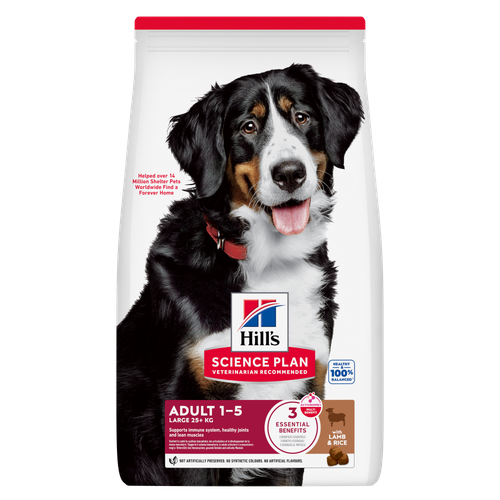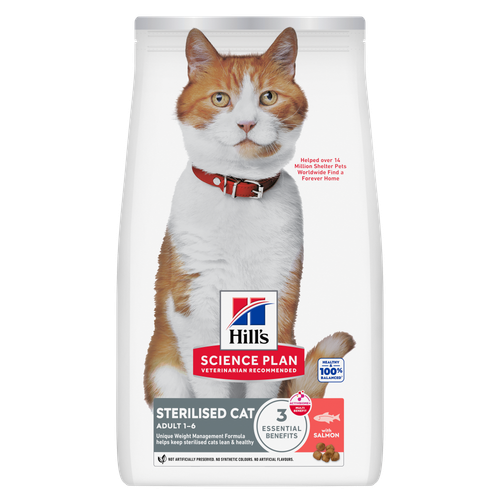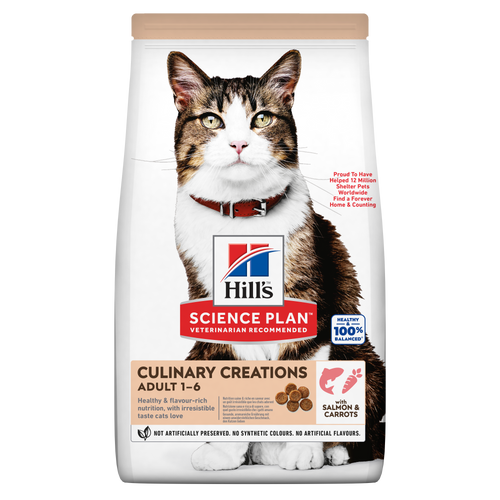
-
Find the right food for your petTake this quiz to see which food may be the best for your furry friend.Find the right food for your petTake this quiz to see which food may be the best for your furry friend.Featured products
 Perfect Digestion Large Breed Puppy Food
Perfect Digestion Large Breed Puppy FoodPrecisely balanced nutrition with Hill's ActivBiome+ prebiotic blend actively contributes to supporting digestive health and overall wellbeing to help your pet feel their best
Shop Now Adult Light Dog Food
Adult Light Dog FoodHill's Science Plan Light Adult Wet Dog Food is a complete premium pet food for adult dogs that tend to gain weight easily. This deliciously smooth loaf is formulated to deliver the appropriate amount of energy to support weight maintenance in adult dogs.
Shop Now Large Breed Adult Dog Food
Large Breed Adult Dog FoodHill's Science Plan Large Breed Adult Dog Food with Lamb & Rice is a complete pet food, specially formulated with ActivBiome+ Multi-Benefit Technology.
This food is specifically designed to fuel the energy needs of large breed dogs during the prime of their life.Shop NowFeatured products Sterilised Adult Cat Food
Sterilised Adult Cat FoodHill's Science Plan Adult Sterilised Cat Dry Food with Salmon is specially formulated with ActivBiome+ Multi-Benefit Technology. It is a precisely balanced nutrition, tailored to meet the needs of sterilised cats, to help keep sthem lean & healthy.
Shop Now Adult Cat Food
Adult Cat FoodHill's Science Plan Adult Cat Food with Chicken is a complete pet food, specially formulated with ActivBiome+ Multi-Benefit Technology.
This food is specially formulated to fuel the energy needs of cats during the prime of their life.Shop Now CULINARY CREATIONS ADULT CAT FOOD
CULINARY CREATIONS ADULT CAT FOODHill's Science Plan CULINARY CREATIONS Adult cat food with Salmon & Carrots was formulated to provide a great-tasting experience to cats. Its delicious flavour and texture are combine with essential nutrients to support cats' optimal health during the prime time of their life. Specially formulated with high-quality salmon protein, essential taurine for heart health & balanced minerals to support kidneys & bladder.
Shop Now -
Dog
- Dog Tips & Articles
-
Health Category
- Weight
- Food & Environmental Sensitivities
- Urinary
- Digestive
- Joint
- Kidney
-
Life Stage
- Puppy Nutrition
- Adult Nutrition
- Senior Nutrition
Cat- Cat Tips & Articles
-
Health Category
- Weight
- Skin & Food Sensitivities
- Urinary
- Digestive
- Kidney
-
Life Stage
- Kitten Nutrition
- Adult Nutrition
Featured articles Pet Nutrition: What Makes "Healthy" Pet Food Healthy? | Hill's Pet
Pet Nutrition: What Makes "Healthy" Pet Food Healthy? | Hill's PetIn people, the right diet is very important. If you are eating the wrong way for your metabolism, activity level, age and lifestyle you could end up with health issues.
Read More The Incredible Science Behind Your Pet's Microbiome
The Incredible Science Behind Your Pet's MicrobiomeLearn what your pet's microbiome is, how it contributes to your pet's gut and overall health, and why nutrition is important in maintaining healthy microbiomes.
Read More Microchipping: The Facts | Hill's Pet
Microchipping: The Facts | Hill's PetThe government has announced that as of April 2016, all dogs in the UK must be microchipped by law.
Read More -


When a pet emergency occurs, it's important to know what to do in the moment of distress. From performing the cat Heimlich maneuver to preventing choking accidents, learn some important ways to help your cat in a crisis.

What Can I Do?
Sometimes a cat choking incident is caused by a hairball that she can't expel, but accidents are more often the result of an object (food, hair tie or plastic toy) lodged in her throat. If you see your cat choking, try to remain as calm as possible while you determine whether or not her airway is really blocked. If it's simply a hairball, she will have it out in a few seconds. If there is an obstruction, you will need to follow two steps.
- Mouth sweep: First, gently open your cat's jaws and sweep her mouth with your index finger to see if you can remove the obstruction. Look inside her mouth while you're checking for an object to avoid pushing anything farther down her throat, says Cat-World Australia, and gently pull her tongue forward to check the back of her throat. If you don't see anything in her mouth or cannot conduct a safe sweep, move on to the Heimlich maneuver.
- Cat Heimlich: When performing a cat Heimlich maneuver you hold your kitty with her back against your chest and her feet hanging. Use your hands to gently but firmly push on her belly in a succession of quick, upward thrusts, about five times. If your first set of blows doesn't dislodge the object, says PetCoach, hold your cat up by her back hips with her head down and gently sweep her mouth again. Tap your hand firmly against her back and check her mouth again. After you remove the obstruction, bring your cat to the nearest emergency veterinary clinic immediately.


Tasty Tips
Can I Prevent My Cat From Choking?
Eliminating cat choking hazards in the first place is a key way to keep your pet safe. Take a walk through your home and think like a cat: What's small, shiny and could be easily swallowed? Common choking hazards include:
- Craft supplies like pom-poms and pipe cleaners
- Rubber bands
- Paper clips and staples
- Plastic bags and cellophane
- Bottle caps and wine corks
- Straws
- Aluminum foil
Curious cats will go exploring when you're not home, so store your stuff in a pet-proof location. Never let your kitty play with trash like wadded-up aluminum foil or plastic bags. She may have fun doing it, but it only takes a second for those objects to become stuck in her throat.

Cat Toy Safety
Some cat toys can be dangerous as well. Avoid toys that have dangling decorations like feathers, bells and googly eyes. Opt for larger toys like balls, toy mice or crumpled pieces of paper that are larger than your cat's mouth. The two of you can enjoy supervised playtime with the popular fishing pole-style toys, but tuck them out of reach when your cat is out of your sight.
Despite the common image of a cute kitten playing with a ball of yarn, it's not safe for your cat to play with any kind of string or ribbons — they are choking hazards. If your cat has a string hanging out of her mouth (or rectum) says Animal Planet, do not try to pull it out. You could damage her throat or intestines. Consider it an emergency situation and contact your veterinarian immediately if you suspect your cat has swallowed string.
What Else Causes Choking?
In rare cases your cat could be hacking and gasping because of an underlying health issue. When your kitty throws up a hairball, for example, she coughs until the pesky wad of hair comes up. This isn't a choking emergency, but it's uncomfortable for your furry friend. A hairball that won't come up could lead to serious medical problems if it becomes trapped and blocks the digestive track. If your cat hacks up a hairball more than once a week or so, talk to your vet about starting her on a hairball control food or other regimen that will keep wads from forming. Hairballs can also be a sign of underlying gastrointestinal disease.
In some cases, the Cornell Feline Health Center notes, frequent gagging may be a sign of a gastrointestinal problem or a respiratory ailment like asthma. To determine what's causing the coughing and find help for your cat, make an appointment with your vet.


Christine O'Brien is a writer, mom, and long-time cat parent whose two Russian Blues rule the house. Her work also appears in Care.com, What to Expect, and Fit Pregnancy, where she writes about pets, pregnancy, and family life. Find and follow her on Instagram and Twitter @brovelliobrien.
Related products

Hill's Science Plan Adult Sterilised Cat Dry Food with Salmon is specially formulated with ActivBiome+ Multi-Benefit Technology. It is a precisely balanced nutrition, tailored to meet the needs of sterilised cats, to help keep sthem lean & healthy.

Hill's Science Plan Mature Adult Cat Food with Chicken is a complete pet food, specially formulated with ActivBiome+ Multi-Benefit Technology.
This food supports graceful aging in cats, providing a synergistic ingredient blend to help support energy & activity levels.

Hill's Science Plan Adult Cat Food with Chicken is a complete pet food, specially formulated with ActivBiome+ Multi-Benefit Technology.
This food is specially formulated to fuel the energy needs of cats during the prime of their life.

Hill's Science Plan CULINARY CREATIONS Adult cat food with Salmon & Carrots was formulated to provide a great-tasting experience to cats. Its delicious flavour and texture are combine with essential nutrients to support cats' optimal health during the prime time of their life. Specially formulated with high-quality salmon protein, essential taurine for heart health & balanced minerals to support kidneys & bladder.
Related articles

Cats with sensitive skin have special needs and even healthy cats can sometimes develop poor skin health. Learn more about sensitive skin symptoms in your cat, what you can do to help your pet feel more comfortable and get recommendations on sensitive skin cat food.

Learn about the causes of cat dermatitis, how to spot the symptoms and the best treatment options. Visit Hill's Pet for detailed guidance and tips.

Understand common skin issues in cats and how to manage them effectively. Learn signs and prevention, and get care tips. Find out more at Hill's Pet.

Learn how your cat's poo can be a good indicator of her overall health, including how to spot unhealthy or abnormal cat poop and what it might mean.

Put your cat on a diet without them knowing
Our low calorie formula helps you control your cat's weight. It's packed with high-quality protein for building lean muscles, and made with purposeful ingredients for a flavourful, nutritious meal. Clinically proven antioxidants, Vitamin C+E, help promote a healthy immune system.
Put your cat on a diet without them knowing
Our low calorie formula helps you control your cat's weight. It's packed with high-quality protein for building lean muscles, and made with purposeful ingredients for a flavourful, nutritious meal. Clinically proven antioxidants, Vitamin C+E, help promote a healthy immune system.

